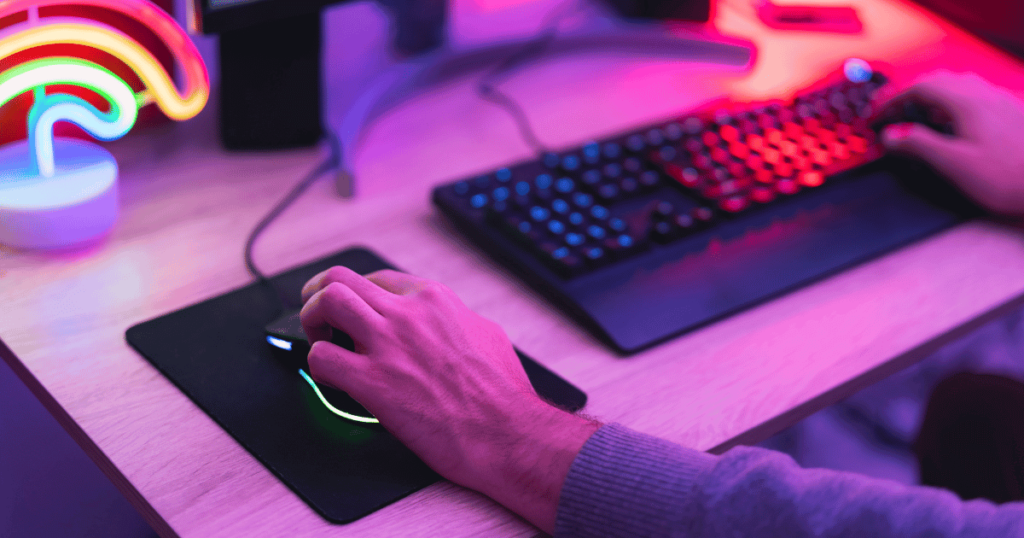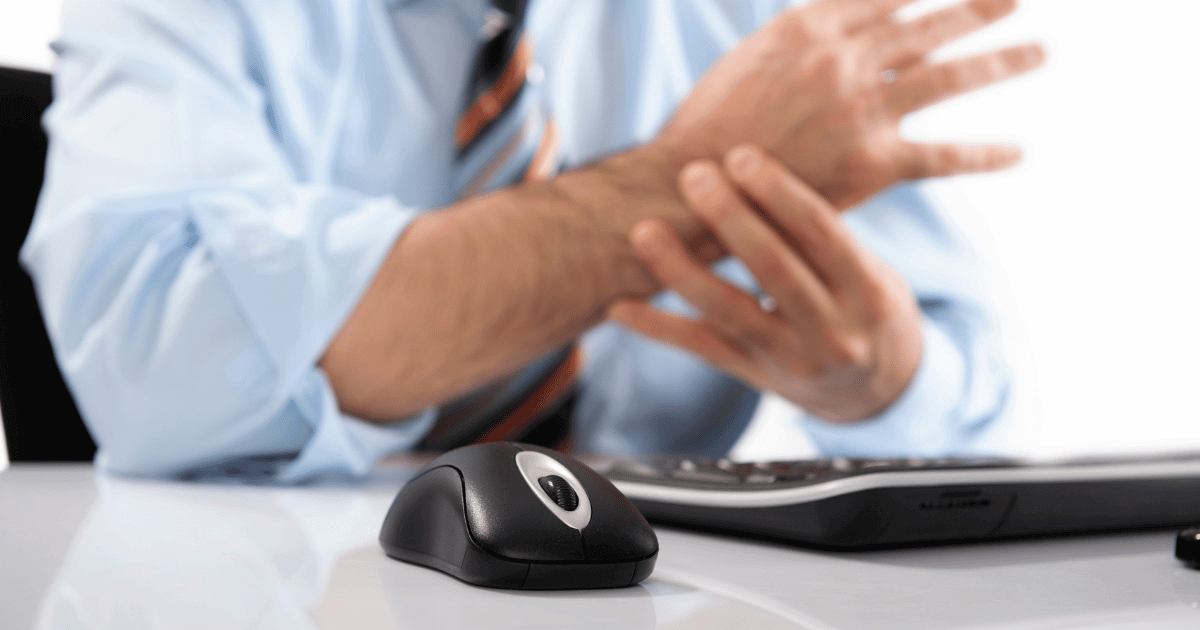Dealing with wrist discomfort after spending hours at the computer can be a genuine pain, quite literally. We’ve all experienced it, whether it’s while working or gaming, that persistent wrist ache that sidelines us. But, there’s hope at the end of the tunnel.
In this article, we’ll provide you with simple yet effective adjustments to your daily routine. These changes are designed to give your wrist the much-needed relief it deserves.
No grand promises, just practical steps toward a more comfortable PC experience.
Let’s get started.
Key Takeaways
- Regular short breaks help alleviate wrist strain during extended PC usage, ensuring your wrists get the necessary rest.
- Choosing a comfortable mouse grip and using ergonomic mouse designs can significantly reduce wrist discomfort.
- Proper sitting posture and desk setup are essential in minimizing wrist stress and maintaining overall hand health.
- Alternating the hand used for the mouse and experimenting with different types of mice can prevent repetitive wrist stress.
Take Frequent Breaks

Taking frequent breaks is crucial for anyone using a mouse extensively, whether for work or gaming. It’s recommended to take a 5-minute break every 60 minutes. By stepping away regularly, you’re giving your muscles and joints the much-needed rest they deserve.
During these breaks, try to shake out your hands and fingers. This simple action can release any tension that’s been building up. It’s an easy yet effective way to reset your hands and wrists, keeping them feeling fresh.
Additionally, whenever it’s possible, consider soaking your hands in warm water during these pauses. This relaxing method helps in loosening up the muscles and can be especially soothing.
Use a Palm Grip Style

Adopting a palm grip style when using a mouse can also reduce strain on your hand and wrist.
In a palm grip, your entire hand rests on the mouse, allowing for a more relaxed posture. This contrasts with the claw or fingertip grips, where there’s more tension in the fingers and wrist.
The advantage of the palm grip style lies in its natural, relaxed position. It allows your hand to rest more neutrally, reducing the strain on your muscles and joints. This is particularly beneficial for those who spend long hours using a mouse, as it minimizes the risk of repetitive strain injuries.
While most mice can accommodate different grip styles, it’s important to choose a mouse that comfortably fits your hand and supports your preferred grip style. A mouse that’s too small or too large can negate the benefits of the palm grip.
Mouse and Wrist Positioning

Getting the positioning of your mouse and wrist right is another paramount factor for comfort and preventing wrist strain.
The key is to maintain a natural, straight wrist position, rather than bending it upwards, downwards, or to the sides. This alignment is important because it reduces stress on the wrist joint and surrounding muscles.
Your mouse should be placed close enough so you can use it comfortably without stretching your arm or shoulder. Think of it as having your favorite drink within easy reach — no need to stretch or strain to grab it.
Also, your forearm should be supported, either by the desk or an armrest, to avoid hovering which can lead to tension.
You should also adjust the height of your chair and desk so your forearm is level with or slightly angled towards the desk when using the mouse. This helps keep your wrist in a strain-free position, preventing discomfort from awkward angles during prolonged use.
Consider Ergonomic Mice

When browsing for PC peripherals, you might have come across mice with unconventional shapes. These are ergonomic mice, specifically designed to support natural hand positioning and reduce strain. Unlike standard mice, ergonomic versions often feature unique designs that encourage a more relaxed grip and wrist alignment.
Choosing an ergonomic mouse involves finding a shape and size that fits your hand comfortably. For instance, some have a vertical design that promotes a handshake-like grip, which can be easier on the wrist. Others might offer enhanced thumb support or varying button placements for easier access.
The goal isn’t just about aesthetics; it’s about finding a mouse that allows you to work or play for extended periods without discomfort.
Avoid Using a Wrist Rest

You might think a wrist rest is a must-have for your desk, but hold on! Surprisingly, research shows that wrist rests might not be as great as they seem. Using one can actually put more pressure on your wrist. Why? Well, your wrist has a “tunnel” inside it, and the bottom part of this tunnel is pretty sensitive to pressure.
This is important because if you press on the wrist (like when you’re using a wrist rest), it can squash this tunnel and make your hand feel numb or tingly. It’s kind of like when you press on your arm for too long and it feels weird.
So, while wrist rests might feel comfy, they could be secretly stressing out your wrist.
Maintain Good Posture

Good posture goes hand in hand with wrist health. Sitting correctly at your desk can greatly influence the comfort of your wrists and hands. Ensure your back is straight, shoulders relaxed, and feet flat on the floor. This alignment sets a foundation that affects how you use your mouse and keyboard.
Your chair should support your lower back, and the top of your monitor should be at eye level to avoid neck strain. This positioning naturally leads to a more comfortable arm and wrist posture, as previously discussed.
When your whole body is aligned well, it reduces the likelihood of stress in any one area, including your wrists.
Alternate Mouse Hand

I know it’s not possible for everyone (including myself), but if you can, alternating the hand you use with your mouse is a smart strategy. Studies have shown that this practice can effectively balance the strain between both hands. Just like alternating your feet while running, using both hands for mouse control can prevent overuse in one hand.
Switching hands might feel awkward at first, but it allows each wrist to rest periodically, reducing the risk of repetitive strain injuries. It’s a bit like giving one hand a break while the other takes over the steering wheel. This doesn’t mean you have to be equally skilled with both hands, but even occasional switching can provide relief.
For those who can manage it, this change, over time, can lead to a more balanced use of muscles and joints, spreading out the workload and potentially leading to less overall discomfort.
Swap Between Mice

I’ve kept this tip for the end as it’s more of a personal insight than a scientifically proven one: swapping between different types of mice. For those who spend long hours using their mouse, this can be a practical approach.
For regular work tasks, where precision may be less of a priority, using an ergonomic mouse like a vertical or trackball mouse can ease the strain on your wrist. These mice encourage different hand positions and movements, which can alleviate repetitive stress.
Then, for activities like gaming, where you need precision and speed, you can switch back to a regular mouse. This strategy not only gives your hand a break from the constant posture of traditional mouse use but also keeps the muscles and joints from getting overworked in one specific way.
This way, you’re not just relying on one type of mouse for all activities, potentially reducing the risk of strain and discomfort.
Conclusion
We hope this article brings you a step closer to the relief you’ve been seeking for your wrists. Simple changes can often lead to the comfort we need, especially during those long hours in front of the PC.
If you’ve found a tip here that works wonders for you, or if you have your own strategies, we’d love to hear about it.
Feel free to drop a comment sharing how long you typically spend at your PC or which of these suggestions has made the biggest difference for you
We're an affiliate
We hope you love the products we recommend! Just so you know, gameraround.com is a participant in the Amazon Services LLC Associates Program, an affiliate advertising program designed to provide a means for sites to earn advertising fees by linking to Amazon.com.

